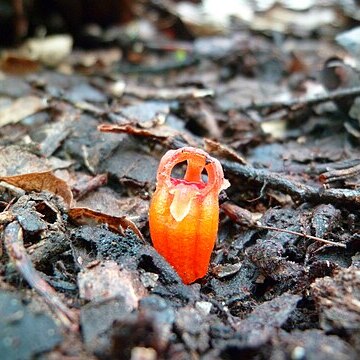Saprophytic, fleshy herbs. Underground part in the Malaysian species coralliform or vermiform and creeping. Stems usually short, seldom branched. Leaves small, scale-like. Below the flowers 1 or more bracts, sometimes forming an involucre. Flowers actinomorphic or, sometimes, zygomorphic, urceolate to campanulate. Perianth lobes 6, occasionally free and of equal length and size, or inner ones larger, sometimes inner lobes connivent at the apex or connate in the apical part, then forming an erect mitre with 3 holes, in that case outer lobes very small. Stamens 6, free or, usually, stuck together to an anther tube, hanging at an annulus in the perianth throat. Filaments short, ribbon-shaped. Style thick, short, cylindrical or conical, persistent, bearing at its apex 3 simple or bilabiate stigmas. Ovary obconical or obovoid; the 3 placentas inserted at the bottom or parietally in the basal part of the ovary. Fruit fleshy, cup-shaped, crowned by the persistent, fleshy, basal ring of the perianth tube and the style with the stigmas.
Fls us. solitary, terminal on short lateral branch, large for size of plant. Per.-tube campanulate to urceolate, circumscissile just above ovary; lobes 6, the inner 3 us. larger and sts connivent or ± connate at their tips to form an erect mitre with 3 openings or fenestrae. Stamens 6; filaments short, attached to annulus at mouth of per.-tube and deflexed inwards; anthers free or connate into a tube, dehiscing by longitudinal slits. Ovary 1-locular, with 3 placentae us. suspended by slender stalks between roof and floor of the cavity; style short and thick; stigmas 3, simple or bilobed. Fr. turbinate, us. fleshy, crowned by thick ring of per.-tube base and by persistent style and stigmas. Saprophytic fleshy herbs perennating by tuberous, coralloid or vermiform subterranean parts. Stems us. short and unbranched. Lvs small, scalelike, those immediately below fl. often forming an involucre. Some 2 dozen spp. of Australia, Indomalaysia, India and America.
Plants annual, without chlorophyll, mycotrophic; tuberous. Stems simple or branched. Leaves cauline, bractlike, small. Flowers 1-4, terminal. Perianth tube actinomorphic to zygomorphic, cylindric, urceolate, or sometimes campanulate, with prominent annulus at mouth, lateral wings absent; tepals 6, apically distinct; outer tepals as long as or shorter than inner tepals; inner tepals sometimes apically connivent or connate into an erect mitre. Stamens 6, generally laterally connate, pendent from annulus, occasionally distinct; connectives with 0-2 apical and 0-2 basal appendages. Ovary obconic or obovoid, 1-loculed, with 3 parietal placentae; stigmas 3, simple or bilabiate. Fruit fleshy with persistent perianth base; dehiscence by abscission of apex.
Plants perennial, mycotrophic, not green. Rhizomes absent. Roots horizontal, stoutly terete. Stems unbranched, very short. Leaves cauline, bractlike, white. Inflorescences solitary flowers; floral bracts imbricate. Flowers erect, neither ribbed nor winged; perianth caducous in fruit; annulus present in perianth throat immediately proximal to lobes; stamens 6, pendent, forming ring proximal to annulus; ovary 1-locular; placentation parietal; pedicel absent. Capsules cup-shaped; dehiscence irregular by breaking down of wall.
Fls regular, wingless; perianth-lobes equal or the inner the larger, the throat partly closed by an annulus; stamens 6, pendent from the annulus within the tube; fr fleshy, crowned by the perianth-tube; fleshy, achlorophyllous herbs, mostly small, with a few minute cauline lvs and 1–few fls. 25, mainly trop.

